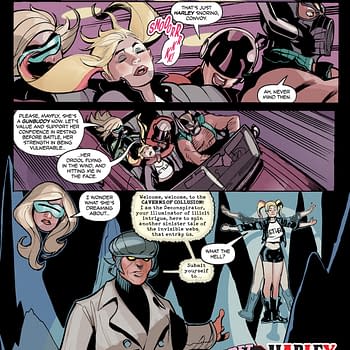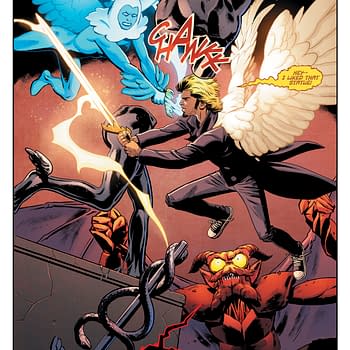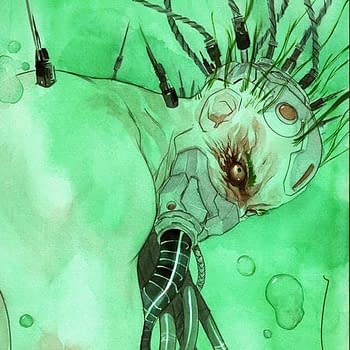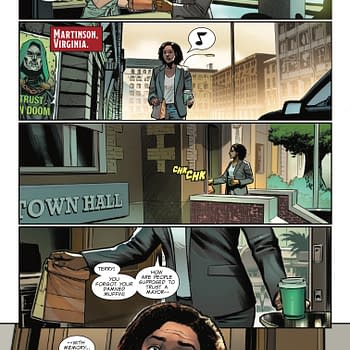Posted in: Comics, Recent Updates | Tagged: Comics, Conan/Red Sonja, entertainment, Fortune #1, Hellbreak, Marvel Comics, oni press, Star Wars #1, Title 18, ultimate spider-man
Thor's Comic Review Column – Star Wars #1, Hellbreak #1, Conan/Red Sonja #1, Fortune, Ultimate Spider-Man #9
Comics Reviewed This Week:
Star Wars #1
Hellbreak #1
Conan/Red Sonja #1
Fortune #1
Ultimate Spider-Man #9
Star Wars #1 (Marvel, $4.99)
By Graig Kent
We all have history with Star Wars, our own experiences with the prequels, and our own feelings around where we stand with the property as a result. For a great many of certain generations, the prequels trampled on a lot of fond memories, and, as a result, they checked out of the galaxy long, long ago and far, far away. In kind of the opposite trajectory of Anakin Skywalker, many view George Lucas as a villain now, as opposed to the visionary hero he once was. For many, Disney's acquisition of Star Wars was the best thing that could have happened. The fevered anticipation for Episode 7 seems like proof, the strays are largely returning to the flock.
Over the past year I've been watching The Clone Wars animated series with my 5-year-old daughter as her gateway into Star Wars, and over this past holiday season we ploughed through all six episodes of "real people Star Wars". Her rampant interest in both the cartoon and the films (and the many toys and books around the house) has awakened me from my own decade long Star Wars coma. What struck me as most interesting watching my daughter watch Star Wars is how she views the six movies as Anakin's arc (she kept referring to Darth Vader as "Anakin" and asking where Ahsoka was). The reveal of Luke and Leia being Anakin's kids, and siblings, was no surprise to her, and Han is a late to the game supporting player in the series. These characters are not the central figures to her, as they were in my youth. With dozens of hours of Clone Wars trumping the runtime of the movie series handily, its easy to see why. I certainly believe there's more kids out there like this, teens and younger who view the world of the prequels as more familiar, and the Original Trilogy more as foreign entities. Its now quite true, given the wipe of the "Expanded Universe", that the fall of the Republic is more explored ground than the story of the rebellion against the Empire.
Marvel's new Star Wars books can be seen as perhaps an antidote to that, a solution to raising the profile of these figures among the younger Star Wars audience. But who are we kidding, Star Wars comics starring Han, Luke, Leia, Chewie and Darth Vader, all taking place in-between "A New Hope" and "The Empire Strikes Back"… these are meant for the old folks, the grumpy complainers who didn't like the prequels because they were different from what they grew up with.
Looking at the first book on its surface, it's a fanservice-heavy but likeable story wherein our expected crew (Luke, Han, Leia, Chewie, Artoo and Threepio) are infiltrating the Empire's weapons manufacturing facility under guise as negotiators for Jabba the Hutt, with a plan on destroying the facility. All the key players are there, including Vader, who turns up as the Empire's negotiator. There are some neat moments: the setup introduces us to where the bad guys stuff comes from; deals in some of the resource and commercial issues of the Empire's operations; there's a nice moment between Han and Leia having a heated conversation about motives that shows their distance and provides a light bridge; and then there's Vader reacting to a sniper, all handled with utter craft and precision from John Cassaday (I don't think I've read a Star Wars comic with better rendered weapons, tech, vehicles and environments).
However, Star Wars #1 triggers my biggest peeve about so many stories set during the Original Trilogy, using these characters, and that's the need to keep the entire gang together. Most of Star Wars, Empire and Jedi feature the characters in some manner of disarray and separation. It seems most of the movies are concerned about bringing them together, or if they start out together then they branch off into their own smaller adventures. As well, it only ever felt like Luke and Vader crossed paths face to face once or twice outside of the films (though the opening crawl of Empire does have Vader actively searching for him), and comics in the past (Marvel's past especially) have thrust them together far too often. There's a real threat that over-exploring the terrain between the films of the original trilogy could dilute their potency.
Beyond just my own personal apprehension about where Jason Aaron will be taking this series, I also have a hard time separating the metastory from the story itself. Aaron, Kieron Gillen (writing the Darth Vader series), and Mark Waid (writing the Princess Leia mini-series) are all known comic book creators, who have a rich history in the industry, they're not flat-out Star Wars guys. Even if they are mega-fans, this feels like a Before Watchmen type gig-for-hire, one that will pay well and provide exposure, but not service the Star Wars universe with any stories that needed to be told. These don't have the feeling of stories that these creators had a burning desire to tell. Given the hullaballoo about these being the first "in canon" Star Wars material in print, this feels as much like filler as it does a part of the saga.
One of my realizations, in watching the Star Wars saga with my daughter, is that the property really is for kids. Oh, it's rich and textured enough to engage adults, for sure, but at a very basic level the fantasy and fiction appeal is something that kids key into far more than adults are generally able to. You have to turn off your critical receptors, you have to open your mind to possibility, let go of your feelings, and you have to just soak Star Wars in, in all its permutations. The more you think about it the dodgier it gets, even the OT. Which I guess is why I found reviewing a new, canonical Star Wars comic so difficult and my response somewhat harsh; I'm having difficulty letting go of my nostalgia, ignoring my expectations, and forgetting years of expanded universe experience.
My daughter quite loved it, and, turning off my own critical receptors, we have the promise of Han driving an AT-AT next issue. Who doesn't want to see that?
Graig Kent was never really that mad at Star Wars, he just ran out of money to keep up. HIs first novel, Quarter City,can be read for free on Wattpad. It's about a fictional city dealing with people with special abilities. You might like it. Graig tweets stuff @thee_geekent and he does various other things in other places.
Hellbreak #1 (Oni Press)
By Bart Bishop

The issue starts off with the story of Orpheus and his descent into Hades to retrieve his wife, Eurydice, after she dies unexpectedly. I, of course, know this story well from its classic retelling in Sandman (who has time for Edith Hamilton? Kidding, I do), and it serves two purposes here: to establish the conflating of infinite doctrines so that every hell can have a turn, and to put a twist on the old tale by showing Lovecraftian horrors snatching Eurydice back into the underworld. This segues into Marik Proctor, the "Senior Project Coordinator, Kerberos Initiative", telling this tale to distraught parents, setting up the premise by showing that their son is trapped in a horrible other dimension and Proctor's men are the only ones that can get him out. This requires a "tether", in this case the son's stuffed animal, and then there's a jump into the real meat of the story: the jailbreak. An elite task forces crashes a party that appears to be the Enlightenment meets Hellraiser, and then the fireworks start.
So it's not Bunn's intention to explore the metaphysical aspects of hell, not just yet, and it's telling that the character of Desmond is not a sinner that has been punished by being sent to hell. Instead, he has been possessed by a demon, by force, and "sold as some sort of party favor", which adds an intriguing bit of minutiae to this whole netherworld business. We'll see if later issues decide to explore the morality of saving someone that is damned, and whether or not the Kerberos Initiative works out of altruism or for incentive. As is, the team is pointedly identified by their names, physical appearance and rank, which is par for the course for a first issue getting all the pieces in place. None of them really stand out, except for the leader Jenner who spouts a harsh bit of cynicism near the end, but I appreciate the establishment of the rules of how this all works, and the "stairwell", the portal back to Earth, not working on first try is an apt little touch that makes this all very relatable.
Like with his work on Big Trouble in Little China, Churilla really excels when it comes to creature designs. From the open to the elegant ball, he gives everything an unnerving touch. I especially liked the mix of the familiar religious iconography with advanced technology, although one panel in particular confused me. When Desmond is shown strapped down in a laboratory, and the fact that he has a stuffed animal, he appears to be a young child. When the team finds him in the hell known as Necropolis, however, he is evidently a grown man. If this is intentional, that he has been in hell this long, then that's fine but as far as I can tell it's not communicated either verbally or in prose. If it's not intentionally, then Churilla made some really odd choices in rendering a child as tall as an older man he's strapped down next to, and with gaunt, mature cheekbones.
While I can't help but think someone like Jae Lee or Ashley Wood would be more appropriate in depicting an ephemeral realm, I acknowledge that it's very much Bunn's intention to ground these hells as physical places that can be traversed. That being said, Churilla makes for a dynamic visual ride, and Bunn lays the groundwork in an efficient and economical fashion.
Editor and teacher by day, comic book enthusiast by night, Bart has a background in journalism and is not afraid to use it. His first loves were movies and comic books, and although he grew up a Marvel Zombie he's been known to read another company or two. Married and with a baby girl on the way, he sure hopes this whole writing thing makes him independently wealthy someday. Bart can be reached at bishop@mcwoodpub.com.
Conan/Red Sonja #1 ($3.99, Dark Horse/Dynamite)
By D.S. Randlett (@dsrandlett)

Thankfully, this turned out to not be the case. Howard's stories tended to present an author in conflict over certain ideals of masculinity and humanity, with his title character acting as something of a reconciliation between opposing poles. Conan, as a character, is often more brutal than anyone else in his world, and more cunning. But by turn, he is also more empathetic than anyone in his world, and he feels more deeply. Busiek's run on the title captured all of that quite well, and ever since he left the title no one has quite struck the same balance with the character, or even with that archetype.
Despite Gail Simone and Jim Zub's talents as writers, they fail to really capture the tension that makes characters like Conan, and his female analog Red Sonja, endure. One of the great things about Howard, and by extension Busiek, was that they didn't shy away from the fact that their characters lived in more brutal times, and their personalities reflected that. There's a tendency to take characters in this subgenre and defang them the longer that certain characters are around for a continuous period of time. It would seem that there's something about Howard's vision that starts out as a difficult examination of life in brutal times wrapped up in adventure stories that causes it to devolve into a much weaker set of tropes. Conan is assuredly an outsider, but I think that the fact that he's ultimately victorious is part of his tragedy. He starts out as free, and then it turns out that he's better than anyone else at playing his culture's games. His tragedy isn't so much that he eventually dies, but that he becomes an insider, and despite the appearances to the contrary, always was.
The first scene in Conan/Red Sonja features a disguised Sonja watched a bout of gladiatorial games where men are fighting and killing animals. Sonja is disgusted by this affair, and immediately this felt like a bit of dissonance to me, as characters like Conan and Sonja would probably be really into events like this. Sonja's disgust doesn't read so much as a genuine character beat as much as it does a way to get the reader on Sonja's side in that moment. And it sort of reveals the approach that this series is taking in regards to the social outsider status of Conan and Sonja. Instead of coming from their marginalized status, the outsider nature of this version of these characters stems from the fact that they are a little better and a little more enlightened than those around them.
That's not to say that Conan/Red Sonja is necessarily bad. Much about it is very good. Even though the series' heavy hasn't really had much time on the page, there's a central MacGuffin that's really creepy. Also, the book just has a really fun, adventurous feel that doesn't shortchange the grittiness of Howard's world. Much of Conan/Red Sonja is just simply a pleasure, and the art by Dan Panosian and colorist (and Conan veteran) Dave Stewart amplifies that effect. Panosian adopts a more cartoony style that really helps sell the tone of fun and adventure that the series is going for while still maintaining a sense of lurid eroticism and violence. His action scenes are particularly fantastic, and he does a really good job of placing the lithe Sonja and the towering Conan on an equal visual footing.
Conan/Red Sonja is certainly fun and well produced, but it puts out a wrong foot in terms of some key character principles and keeps it from being a truly worthy entry into the gritty Sword and Sorcery canon. Still, for fans of these characters who have been yearning to see them reunited, the book checks enough boxes to be worth checking out.
D.S. Randlett lives in the hills of Virginia and takes credit for the reviews that his emaciated twin brother writes while chained to the old radiator. He plays his guitar while biding his time for unsuspecting tourists and thinking about going to grad school.
Fortune #1 (Title 18, $0.99)
By Cat Taylor

As for the execution of the concept, I am disappointed to say that the first issue doesn't deliver enough story or information to make an informed recommendation to buy or stay away. The story flew by without conveying much detail on the characters. Regarding the story of the first issue, it is simply one of the jobs that the two main characters are pulling to make a little money. In this case, one of the characters wants to make this his last job for a while since his girlfriend is withholding sex until he can stop smelling like fast food. The girlfriend is unaware that her man's French fry smell comes from grand theft. On the contrary, she thinks she's dating an average young fast food clerk who is just trying to earn a few honest dollars until he gets a real career.
Visually, this issue isn't bad, but it's not exceptional either. I will say that like the story concept, the art isn't the standard Marvel or independent style that is so commonly used by most artists. Instead, the art looks more like the illustrations I used to see from students in college Life Drawing classes. The figures are static and quickly rendered outlines that emphasize important details that make them seem like real people instead of comic book heroes. It also appears that the artist, Dillon Samuelson, colored the drawings with watercolor paints rather than a more modern or sophisticated process. Overall, I'll give the art a few points for originality.
While I can't guess whether this series is going to be any good or not, the theft of the large drums of contraband and the deception of the girlfriend regarding the criminal activity at hand reminded me of the first season of Breaking Bad, which everyone seems to worship. However, the resemblance at this point is purely superficial. The tense moments, character development, and humor that added to the quality of Breaking Bad are so far absent in Fortune. Touches like that may come with later issues but if so, I'm surprised that the writer, Erik Arneson, didn't make sure to include more hooks like those in this debut issue. After all, you know what they say about first impressions.
Cat Taylor has been reading comics since the 1970s. Some of his favorite writers are Alan Moore, Neil Gaiman, Peter Bagge, and Kurt Busiek. Prior to writing about comics, Taylor performed in punk rock bands and on the outlaw professional wrestling circuit. During that time he also wrote for music and pro wrestling fanzines. For some reason, Taylor has been watching a lot of old TV shows and movies lately, and you feminists should be appalled! The women in these things go into absolute hysteria at the smallest social offense. "Oh dear, what of the reputation to our family if you wear such wrinkled attire?!" You can e-mail him at cizattaylor@hotmail.com.
Sins of Our Fathers: What Miles Morales: Ultimate Spider-Man #9 Taught Me About My Relationship with My Parents
By Adam X. Smith

After accidentally being bitten by one of the same spiders that transformed Peter Parker into Spider-Man, gifted pre-teen Miles Morales develops powers almost identical to Parker's. When Miles witnesses the death of Peter Parker whilst battling the Green Goblin and learns of his origins, he takes it upon himself to continue his legacy. This is complicated by his father Jefferson Davis' anti-mutant/superhero prejudice.
Then Miles' criminal uncle Aaron, aka The Prowler, tried to blackmail him and died in a battle between the two of them. And shortly after that, Miles' mother Rio was killed by a stray police bullet during a fight with Venom, prompting a grief-stricken Miles to declare "No More!" and hang up the costume for a year.
Upon Miles' eventual return to web-crawling, he is confronted with the possible destruction of Earth by Galactus. He reveals his identity to his father, who rebuffs him and leaves.
Now, Miles finds that Jefferson has returned to drag some old skeletons out of the closet…
One of our fellow writers, Bart, is about to become a father. At the time I didn't know exactly how to respond to this other than wishing him the best of luck, as I had no life experience of being a father or knowing my own father as a child. Having had time to reflect, I think I have at least one piece of advice for him: be the kind of father you'd want to have had as a child, whatever that might entail.
Spider-Man comics have always had a sort of arch soap opera-esque quality to them – their preoccupation with the trials and tribulations of their protagonist in and out of the costume has made it one of the most beloved and consistently relevant superheroes in the canon. When he's not getting cloned or having his marriage retconned out of existence, of course. Nevertheless, following the life of Peter Parker, and now Miles Morales, fills the same appeal that my parents' generation has for daily or weekly soaps – seeing the loveable klutz behind the mask is just as dramatically interesting as the colourful escapades he and his rogues' gallery get into. This comes primarily from Parker being not just a wish fulfilment figure but someone whose more banal problems – making the rent and getting the girl and making his Aunt May proud – are things we as an audience can relate to. Batman and Iron Man may well be cool on the surface level, but no-one who hasn't been in the Forbes 400 can come close to really "getting" what it's like to be truly super-rich enough to own a fully functioning Batmobile.
So then, after a whole bunch of issues waiting for the other boot to drop, Brian Michael Bendis and David Marquez reveal a whole bunch of stuff over the course of issues #8 and #9 that adds a completely different context to everything that has occurred to Miles since before the series even began, and our relationship with Miles as an audience becomes that much more layered and emotionally deep as a result.
Having revealed in the last issue that he had been recruited by a young Nick Fury to infiltrate the organisation of then-rising Kingpin of Crime Wilson Fisk, Jefferson tells his son how he came to be involved in the sting that first sent Fisk to prison. In Graig's review of volume 1 of the series (which I only managed to catch up on over Christmas), he points to Bendis' handling of Miles' private life being the real standout achievement of the series, and it's continued here in the way he balances the flashback A-story with the more emotionally loaded wraparound in which Miles and Jefferson are sitting on a Central Park bench, pouring their hearts out to each other whilst people in the background obliviously get on with their lives. Jefferson is a man who has been running from the past a long time, and when it confronts him in the form of his son being a masked vigilante, his first reaction is to bail on him. Now he is reaping twenty-five years of secrets and lies he's told his son, and that it is a credit to those involved in creating the book that the execution of it, from the art to the dialogue to the emotional payoff, is as heart-breaking and earnest as it is.
Okay, in case some of you hadn't picked up on it, certain themes in this story stuck with me for personal reasons, so if you really don't give a shit about what I think or say, you've got a free pass to just jump to whatever Jeb has placed before or after this. But in the interest of integrity and my own peace of mind, I think it's important and relevant that I make a few things clear.
Without going into details, my father died when I was 15 months old; he was 28. I've known for some time that he committed suicide, but it is only recently (over the holidays, in fact,) that certain information has indirectly been passed on to me regarding the nature of his final days, including the fact that he was most likely clinically depressed and suicidal at the time, exacerbated by heavy use of cannabis and guilt over other misdeeds. This information, naturally, recontextualises certain things in my own life, but one thing hasn't changed: I don't yet have the courage to talk to my mother about this, and based on how the information came to me, I worry that she doesn't either.
For a long time my mother and I have danced around this topic of discussion; naturally, there's rarely ever a good time to discuss it. There have often been times in the past when this or other difficult topics were dragged into the open; in such cases, it rarely resulted in anything like a pleasant or even cathartic conclusion. The fact is it is easy to tell your children that honesty is the best policy, but an entirely different matter to practice it, especially when there are topics you would rather never have to discuss with your child.
However, since I'm airing my dirty laundry in public anyway, I feel that it's as good a time as any to say this: to any parents out there, your children may be young now, but they are smarter than you may well credit them for. They can handle the truth, so long as you are open and honest with them; however hard that might seem, shielding them from it never leads to anything good in the long run. And kids/young adults/Millennials/whatever, go easy on your parents; they might not get everything right – God knows, no-one's perfect – but they got you this far, and they didn't have the benefit of the internet to answer their math problems or air their grievances about current TV shows.
And to my own mother: if you're reading this, thank you for getting me this far. I know you will probably always worry that I might end up like my father; that's something I can't promise won't happen, but I can promise you that, having recently turned 28, I've never felt more alive, I've got everything to live for, and I have no intention of stopping now. Someday, and that day may never come, you and I will be ready to have the discussion, calmly and as equals, without tears and recriminations. Until then, know that I love you, and that you've only ever done right by me.
And for those of you who managed to get through this whole piece, next week there'll be an actual review of something that came out recently. Scouts honour.
Adam X. Smith is a paranoid android from the Planet X. For the last 27 years he has been living amongst the people of Birmingham, England (and more recently the University of Lincoln) ostensibly as a student of the school of hard knocks (also BA Hons Drama), but secretly on a mission to scout out the planet for invasion by alien forces; his weekly communiques on his various blogs are actually highly coded messages to his extra-terrestrial masters. He enjoys the musical stylings of local chiptune-metal band Elmo Sexwhistle, the fiction of Kim Newman, Kurt Vonnegut and Chuck Palahniuk, and his hobbies and interests include film-making, drama, occasional Youtubing, journalism and plotting the subjugation of humanity. He can be found on Youtube, Tumblr, Twitter or by jamming an ice-pick through the optic chiasm.
















